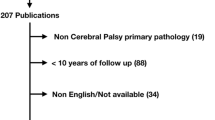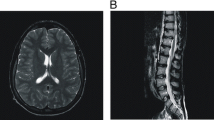Abstract
Background
Spasticity is motor disorder characterized by a velocity-dependent increase in tonic stretch reflexes (muscle tone) with exaggerated tendon jerks, resulting from hyper-excitability of the stretch reflex, as one component of the upper motor neuron syndrome.
Purpose
This study aimed at comparing between spinally based (dorsal rhizotomy) versus peripherally based (selective neurotomy) surgical procedures in management of hypertonia in the lower limbs of pediatrics.
Methods
Over a 3-year period, 50 children with intractable, lower limb spasticity were prospectively treated by selective neurotomy (group A, 35 patients) and dorsal rhizotomy (group B, 15 patients) with 6 months’ follow-up period.
Results
The operative duration was longer with dorsal rhizotomy with mean of 292.2 min versus 76.8 min with neurotomy (P = 0.001) and the hospital stay of dorsal rhizotomy was longer with mean of 6.2 days versus 1.7 days with neurotomy (P = 0.001). Muscles power exhibited significant improvement in 53.3 % of the total rhizotomies (P = 0.001). Following neurotomies; muscle tone showed marked improvement in 69.3 % muscles which had normal tone and 31.9 % of muscles had mild spasticity (P = 0.001). The H/M ratio following dorsal rhizotomies showed marked reduction of the ratio, and the mean was 0.11 versus 0.58 preoperatively.
Conclusion
Both neurotomies and dorsal rhizotomies were safe surgical procedures and were provided with good improvement in respect of: muscle power, severity of spasticity, patient’s ambulation, gait, range of joint movement, associated pain, functional disability, and nerve excitability with no significant difference between both procedures.
Similar content being viewed by others
Abbreviations
- H/M ratio:
-
H-reflex/M-response
- UMNL:
-
Upper motor neuron lesion
- MRCs:
-
Medical Research Council scale
- DREZ:
-
Dorsal root entry zone
- CBC:
-
Complete blood picture
- CT:
-
Computerized tomography
- MRI:
-
Magnetic Resonance Image
- SPN:
-
Selective peripheral neurotomy
- ITB:
-
Intrathecal baclofen therapy
References
Bhimani R, Anderson L (2014) Clinical Understanding of spasticity: implications for practice. Rehabil Res Pract 2014:279175
Buffenoir K, Decq P, Hamel O, Lambertz D, Perot C (2013) Long-term neuromechanical results of selective tibial neurotomy in patients with spastic equinus foot. Acta Neurochir 155:1731–1743
Gäverth J, Sandgren M, Lindberg P, Forssberg H, Eliasson A (2013) Test-retest and inter-rater reliability of a method to measure wrist and finger spasticity. J Rehabil Med 45(7):630–636
Campistol J (2003) Orally administered drugs in the treatment of spasticity. Rev Neurol 37(1):70–74
Dario A, Tomei G (2004) benefit-risk assessment of baclofen in severe spinal spasticity. Drug Saf 27(11):799–818
Kan P, Gooch J, Amini A, Ploeger D, Grams B, Oberg W, Simonsen S, Walker M, Kestle J (2008) Surgical treatment of spasticity in children: comparison of selective dorsal rhizotomy and intrathecal baclofen pump implantation. Childs Nerv Syst 24(2):239–243
Kheder A, Nair K (2012) Spasticity: pathophysiology, evaluation and management. Pract Neurol 12(5):289–298
Lazorthes Y, Sol J, Sallerin B, Verdié J (2002) The surgicalmanagement of spasticity. Eur J Neurol. 9(1):35–41 (dicussion 53–61)
Marrawi J, Mertens P, Luaute J et al (2006) Long term functional results of selective peripheral neurotomy for the treatment of spastic upper limb: prospective study in 31 patients. J Neurosurg 104(2):215–225
Mayer M (2002) Neurophysiological and kinesiological aspects of spastic gait: the need for a functional approach. Funct Neurol 17(1):11–17
Ozcakir S, Sivrioglu K (2007) Botulinum Toxin in Poststroke Spasticity. Clin Med Res 5(2):132–138
Reynolds R, Morton R, Walker M, Massagli T, Browd S (2014) Role of dorsal rhizotomy in spinal cord injury-induced spasticity. J Neurosurg Pediatr 14(3):266–270
Rode G, Maupas E, Luaute J, Courtois-Jacquin S, Boisson D (2003) Medical treatment of spasticity. Neurochirurgie 49(2–3 Pt 2):247–255
Roujeau T, Di Rocco F, Zérah M (2008) Transition from childhood to adulthood and management of spasticity]. Neurochirurgie 54(5):618–620
Scheinberg A, Hall K, Lam L, O’Flaherty S (2006) Baclofen in children with cerebral palsy: a double-blind cross-over pilot study. J Paediatr Child Health 42(11):715–720
Steinbok P (2013) Long-term effect of selective dorsal rhizotomy. Dev Med Child Neurol 55(7):586
Steinbok P (2015) Outcomes after selective dorsal rhizotomy. Dev Med Child Neurol 57(3):214–215
Taira T, Hori T (2008) Selective peripheral neurotomy and selective dorsal rhizotomy. Brain Nerve 60(12):1427–1436
Taricco M, Pagliacci M, Telaro E, Adone R (2006) Pharmacological interventions for spasticity following spinal cord injury: results of a Cochrane systematic review. Eura Medicophys 42(1):5–15
Author information
Authors and Affiliations
Corresponding author
Ethics declarations
Conflict of interest
None.
Additional information
This article, ‘Surgical management of intractable spasticity’, Mohamed I. Barakat, Waleed Elhady, Mohamed Gouda, Mahmoud Taha and Ibrahim Metwaly published in European Spine Journal, March 2016, Vol. 25, Issue 3, pp 928-935, First online: 14 December 2015, DOI 10.1007/s00586-015-4326-y, has been retracted at the request of the Editor-in-Chief because this article has considerable overlap with the paper published in the Zagazeg University Journal, Egypt, ISSN 1110-1431, in 10-9-2012. Therefore it does not represent entirely original material and has to be withdrawn. The authors have agreed to retract the article, recognizing that it constitutes duplicate publication. In addition Mohamed Gouda asked to remove his name from the paper as a co-author because he had no direct or indirect relations with this paper.
About this article
Cite this article
Barakat, M.I., Elhady, W., Gouda, M. et al. RETRACTED ARTICLE: Surgical management of intractable spasticity. Eur Spine J 25, 928–935 (2016). https://doi.org/10.1007/s00586-015-4326-y
Received:
Revised:
Accepted:
Published:
Issue Date:
DOI: https://doi.org/10.1007/s00586-015-4326-y




